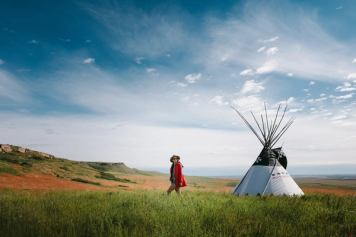Chirps from a multitude of crickets emanate from the sun kissed golden fields of grass overlooking the gentle valley of the Milk River in Southern Alberta. A lone white wooden building, the region’s first Royal Canadian Mountain Police outpost from 1889,sits among the shrubs and brush. Yet what makes this beautiful location a treasure to be preserved forever, unfolds on a sandstone rock face on the valley walls below.
Etched on the sandstone walls of the Milk River Valley, are the preserved stories of the First Peoples of this land. These types of recorded history typically fall into two categories: petroglyphs and pictographs. Pictographs are art created by painting onto a surface, whether through Ochre or other natural dyes and pigments, while a petroglyph is art carved directly into the surface.
A window into Alberta’s vibrant past
No story of Alberta’s history is complete without acknowledging and understanding the Indigenous experience and the land’s importance to them, which continues to this day. The First Peoples of Alberta left stories on the very land that meant so much to them. Their petroglyphs and pictographs are hidden throughout the province in some of the most picturesque surroundings. Their lives and preserved experiences are treasures to be found for the adventurous and curious travellers looking to understand the true beginnings of Alberta’s history.
Protecting these stories is of the utmost importance for all who visit these sites. Susceptible to erosion and weathering over time, these sites have also been damaged, some beyond repair, by human vandalism. While some sites have protection surrounding the walls to prevent such vandalism, others do not.
Some sites are faint at best, and some are only visible with scientific equipment. These sites are deeply important to Indigenous people and should be treated with respect. When viewing petroglyphs and pictographs, it’s vital not to touch the art or disturb the surrounding rocks. The oils on our skin can damage and weaken both. Take photos from a safe distance and if you witness any abuse or vandalism of these sites, contact local authorities. Above all else, please do not touch, climb or disrespect these sites.
Where to find petroglyphs and pictographs
People have travelled across Alberta for thousands of years, where the towering peaks of the Rocky Mountains cede to rolling foothills before the skies open up to the endless plains. Surrounded by freshwater, shelter and food, it’s no wonder why some of Canada’s oldest known evidence of human settlement is found here.
Here are just a few of the locations publicly accessible that each contain a piece to the puzzle of Alberta’s history.
Writing-on-Stone Provincial Park / Áísínai'pi (Southern Alberta)
Writing-On-Stone Provincial Park, also known as Áísínai'pi (“it is written” in Blackfoot), is a UNESCO World Heritage Site featuring one of North America’s most extensive and well-preserved collections of petroglyphs and pictographs. Located in the heart of traditional Blackfoot territory (Nitawashin), this site holds deep spiritual significance for the Kainai, Piikáni, Siksika, and Amaskapipiikani tribes. With over 80 archaeological sites, some dating back over 4,500 years, it illustrates the Blackfoot’s long history in the Milk River Valley.
The site’s petroglyphs, visible through a short yet occasionally challenging hike through towering hoodoos and hills, span from the late 1800s to over 5,000 years old. Carved into the soft rock of the valley floor, a story is told of a dramatic clash roughly 150 years ago: a camp besieged by warriors on horseback, wielding the newest of technologies – the gun. Against them, a line of defenders return fire with gun and bow, and ultimately in vicious hand to hand contests. Other petroglyphs depict Bison, hunters with bows, and human figures carrying shields
The park offers interpretive tours and you can also book private tours with knowledgeable Elders through Spotted Eagle. Remember, do not touch any petroglyphs if you find them in the backcountry to preserve their integrity.







